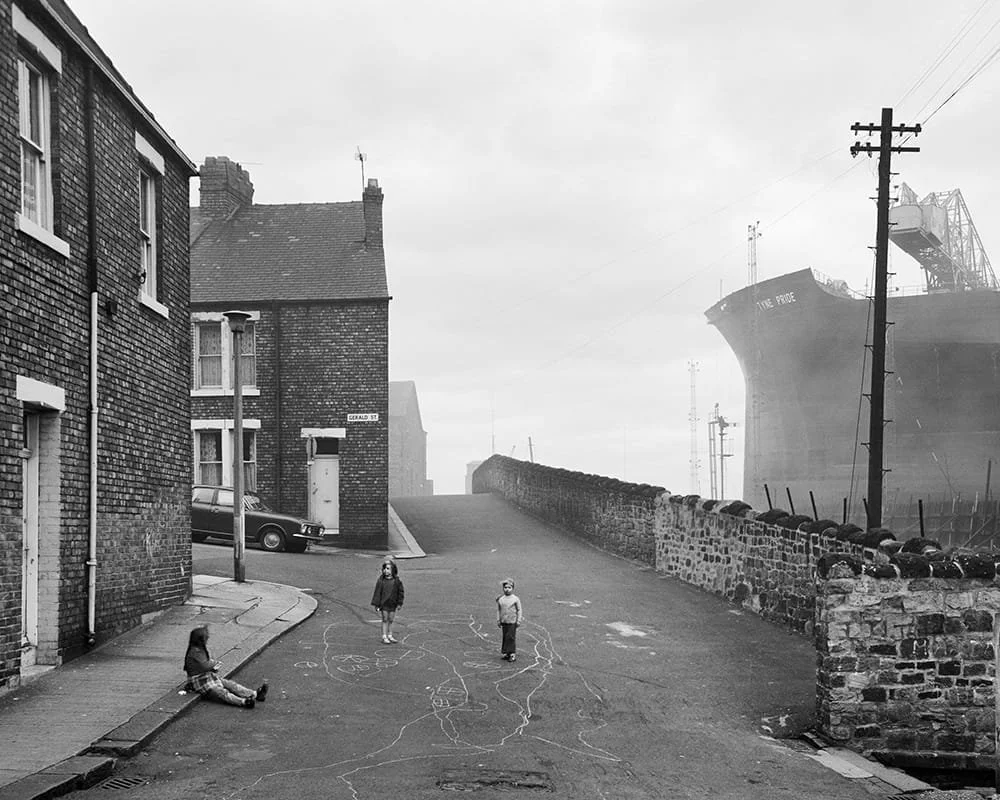After spending thirteen months designing the new library of 180 brushes for the Procreate 5.4 update, Kyle T. Webster discusses the anxieties associated with releasing a product into the world, and how to cope/counterbalance the inevitable criticism. The brushes look amazing. I must delve into Procreate a bit more – my iPad now only works when plugged in, which isn’t exactly ideal, so maybe I’ll find a spare socket and make a little drawing nook.
Lee Friedlander
Can’t stop looking at Lee Friedlander photos. His use of frames within frames (windows, doors, mirrors, television screens) – an additional layer of mystery about what’s happening inside and outside the image’s border – very much appeals to the rectangulist in me.
Antaccent
Scientists are witnessing the birth of a new accent in Antarctica. With an international population that fluctuates seasonally between one and five thousand, it’s fascinating how all those coming-and-going voices are gradually creating something new. It’s expected something similar will happen once we settle Mars – as Jason points out, it’d be great to see the germ of this in the new season of For All Mankind.
Nimona
Having discovered there’s a deluxe limited edition tenth anniversary version of ND Stevenson’s Nimona coming out in May, I watched the wonderful film yet again. I was always disappointed they never got around to publishing a making-of book – but upon further googlage, it turns out they kind of did! Put together by the film’s production designer Aidan Sugano, The Art of Nimona is a 360-page, entirely free PDF. It’s a thorough exploration of how they developed the film’s distinctive look, described by Sugano as a blend of Syd Mead, Eyvind Earle and Charley Harper. Stevenson’s introduction highlights the chaos that is essential to creation:
Nimona was pink because I could only find a pink pen the day I started sketching her. She lived in a medieval future because I liked drawing knights but not horses, laser cannons but not spaceships. Her first transformation was going to be into a T. rex, but sharks were easier to draw; and the shark had boobs because it was 5 a.m. and my life was falling apart and that meant it was objectively the funniest joke in the world. Even her name just kind of … happened, a result of writing down the first syllables that came to mind and telling myself I'd come up with a real name later.
Timequake
This passage from Kurt Vonnegut’s 1997 novel Timequake, recently bloosked by John Self, feels exceedingly relevant to the current state of creative affairs:
People capable of liking some paintings or prints or whatever can rarely do so without knowing something about the artist. Again, the situation is social rather than scientific. Any work of art is half of a conversation between two human beings, and it helps a lot to know who is talking at you. Does he or she have a reputation for seriousness, for religiosity, for suffering, for concupiscence, for rebellion, for sincerity, for jokes? There are virtually no respected paintings made by persons about whom we know zilch. We can even surmise quite a bit about the lives of whoever did the paintings in the caverns underneath Lascaux, France. I dare to suggest that no picture can attract serious attention without a particular sort of human being attached to it in the viewer’s mind. If you are unwilling to claim credit for your pictures, and to say why you hoped others might find them worth examining, there goes the ball game. Pictures are famous for their humanness, and not for their pictureness.
Götz Valien
“I add the human touch” – Berlin’s last cinema poster artist Götz Valien recreates promotional adverts in giant hand-painted images that add a distinct pop art flourish.
Ware
Chris Ware on Richard Scarry and the art of children’s literature:
The thing is, “people” weren’t anywhere to be seen in Best Word Book Ever. Instead, the whole world was populated by animals: rabbits, bears, pigs, cats, foxes, dogs, raccoons, lions, mice, and more. Somehow, though, that made the book’s view of life feel more real and more welcoming. A dollhouse-like cutaway view of a rabbit family in their house getting ready for their day didn’t seem to just picture the things themselves—they were the things themselves, exuding a grounded warmth that said, “Yes, everywhere we live in houses and cook together and get dressed, just like you.”
One must never underestimate the power of anthropomorphism in normalising empathy and diversity for children. I grew up with countless Scarry titles (to this day Peasant Pig and the Terrible Dragon is one of my favourite books) and they definitely shaped my view of the world.
Google Volume 2
Twelve years ago, Felix Heyes and Ben West’s book Google volume 1 replaced thousands of words and their meanings with the first image that appeared when the word was searched for on Google Images; a testament to the visual culture of its time. Google volume 2 updates the experiment with 25,000 images on 1368 pages, and an introduction by Douglas Coupland. It’ll be interesting to compare the two books (and hopefully one day a third), to see if/how AI-generated sludge has infected culture.
K-Type
Always pleasing when a job comes along and you realise you have absolutely the perfect research material on your bookshelf that has just been waiting for its moment in the sun. This week I’ve been absolutely battering Alistair Hall’s excellent London Street Signs for a thing; and subsequently drawing upon the sign-inspired type from Keith Bate’s foundry K-Type.
Cover Meeting
“I’m into the idea of making stuff that doesn’t look like a book cover … something that doesn’t look like it fits perfectly in” – Steve Leard’s Cover Meeting podcast is back with a second season of talks with book cover designers, kicking off with one of my favourites, Jack Smyth, talking about working with art directors as a freelancer, the growing scourge of design-by-committee and why we don’t need more quotes on covers; followed by Sarah Wasley, Production Director and Design Director (aka “the bossy person that sets deadlines”) of Granta Books, on the importance of developing a thick skin by working in-house before going freelance, and how she collects freelancers like Pokémon.
Some hyperlinks
A grab-bag of hyperlinks:
Love these Ikea ads.
In a time when Ai-powered imaging software tweaks and smooths every digital photo to appear perfect, some photographers are embracing the quirky flaws of vintage digital cameras.
A Looking at Picture Books commenter has spotted an unexpected connection between Maurice Sendak’s Where the Wild Things Are and Piero della Francesca’s Dream of Constantine fresco in Arezzo.
Loving these polaroid composite-collages by Cyrus Mahboubian. Must get myself some black and white film and have a play.
Ultramarine
Jolly nice to find my cover for Mariette Navarro’s Ultramarine on Casual Optimist’s Book Covers of Note. Other roundups are available: Literary Hub’s 13 Best Book Covers of March, PRINT’s 20 of the Best Book Covers for March 2025, and Spine’s Book Covers We Love. Am I missing any?
Dookie
Thirtieth anniversary edition of Green Day’s Dookie is being released on obscure, obsolete and inconvenient formats – including toothbrush, wax cylinder and Teddy Ruxpin. Yeah it’s a gimmick, but given that half the people who buy vinyls don’t even have record players, sure, why not, physical media is physical media.
Dookie
Thirtieth anniversary edition of Green Day’s Dookie is being released on obscure, obsolete and inconvenient formats – including toothbrush, wax cylinder and Teddy Ruxpin. Yeah it’s a gimmick, but given that half the people who buy vinyls don’t even have record players, sure, why not, physical media is physical media.
White House
The White House briefing room has been taunting us with hilarious kerning and three upside-down Hs since 2007 and it must be stopped. End this madness.
Move
In this week’s Things I Don’t Understand Or Need: the new Ableton Move. I totally get the tactile appeal of synths – we are the generation that grew up watching people twiddle colourful knobs on spaceships and now it’s our go but the future arrived and it’s all flat and glass and boring. Let us twiddle.
Blur
My first ever Wikipedia edit! Added photographer credit to Blur’s Blur, having discovered the shot in question s by Scott Goldsmith. I reached out to him for more details:
I was on an assignment at a Pittsburgh hospital … my camera was mounted on a tripod down a long hall when I noticed the gurney rolling by. I happened to be at a low shutter speed and I instinctively started to shoot. It was a nice surprise when the film was processed.
Wikitok
Wikitok is my new favourite distraction. It’s basically a continuous TikTok format that serves up endless random Wikipedia articles and oh boy it is ADDICTIVE. I’ve added it to my home screen as an app, and it’s a great way to scroll away a few moments. It was created by developer Isaac Gemal in ninety minutes, which is all kinds of ridiculous. I particularly like the fact he’s kept it genuinely random – “I have no grand plans for some sort of insane monetized hyper-calculating TikTok algorithm … It is anti-algorithmic, if anything” – which makes it even more startling how certain topics appear over and over again. For example, it would appear that the majority of human knowledge revolves around defining species of beetle.
The stock library of the past
Not all borrowing is the same. From public domain illustrations on book covers to AI’s data hoarding, who really owns culture – and who gets away with taking it? Elizabeth Goodspeed on what happens when we treat the past like a stock library.
The Last Ships
We visited Newcastle’s Laing Gallery on the weekend and accidentally stumbled upon The Last Ships; an entire room of Chris Killip’s photography documenting the rise and fall of the shipbuilding trade in the North East of England in the 1970s. It is of course stunning, this pair of images being particularly devastating. Only grumble: for some reason it’s barely signposted in the gallery in any way.

